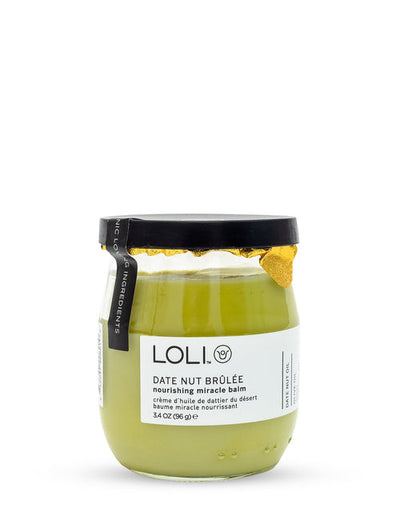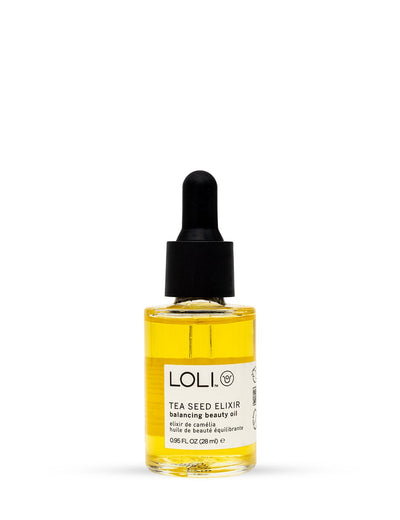Pack4Good
ANCIENT AND ENDANGERED FOREST CONSERVATION POLICY FOR PAPER AND PAPER-BASED PACKAGING
LOLI Beauty is on a mission to clean up the dirty business of beauty to make a conscious change. This means we’re committed to sustainability in our uses of all forest-based products, including helping to protect the world’s forests through our approach to procurement of pulp, paper and packaging.
It is recognized that the expected increase in demand for forest-based products as a substitute for plastics cannot be met sustainably by the current system. Significant changes must occur in paper and packaging production, recycling and reuse in order to support the necessary shift away from single use plastics concurrent with conservation of Ancient and Endangered Forests.
Design and Prioritization of Reduction and Reuse
The reduction and reuse of paper and packaging is of paramount priority for the protection of the world’s limited forest resources and has a clear and beneficial impact on reduced costs. Most often sustainability initiatives pay off on longer time horizons, in the case of reduction and reuse the economic and environmental benefits can be seen immediately.
Therefore, over the next year, LOLI Beauty with the support of Canopy will prioritize the development of a reduction and reuse strategy with targets and timelines. Within this strategy, for the paper and packaging products we continue to need, we will also explore the use of lowest foot print materials, such as post-consumer recycled and agricultural residue content. Over the next 3 years LOLI Beauty will:
- Source or design re-usable/refillable shipping boxes to reduce corrugated paper and paperboard
- Continue to prioritize, design and implement e-commerce, shipping, display and wrapping systems that minimize the use of paper
- Continue to prioritize and utilize re-useable packaging systems for intra business applications
- Increase the use of digital communication, marketing and accounting systems. LOLI Beauty’s office, administration, marketing and management team have already adopted paperless policies.
- Continue to lead the industry by adopting and implementing best practices including researching and applying emerging and circular economy innovations.LOLI Beauty has eliminated all secondary paper-based packaging and is developing unique, upcycled and “grown” bio-based materials for packaging and marketing materials.
Improve Environmental Quality of Paper/Packaging
LOLI Beauty will collaborate with Canopy, innovative companies and suppliers to encourage the development of next generation solutions and paper and packaging sources[i] that reduce environmental and social impacts, with a focus on agricultural fibres (particularly residues)[ii] and recycled content. We will use Canopy’s Ecopaper database and The Paper Steps as a guide for paper and packaging sourcing.
To help reduce pressure on forests and freshwater systems, as well as to reduce the carbon footprint of the paper and packaging we use[iii], LOLI Beauty will:
- Give preference to paper/packaging with high-recycled content, specifically post-consumer waste content;
- Encourage our suppliers to continuously improve and expand the availability of recycled content in papers/packaging;
- Maximize the overall recycled fibre content of our papers/packaging to a minimum average of 50% within 3 years;
- Source papers/packaging from alternative fibres such as wheat straw or other agricultural residues, when possible;
- Support research and development of commercial scale production of pulp, paper and packaging from alternative fibre sources such as wheat straw, and other alternative fibres;
- Participate in alternative fibre paper and packaging trials as appropriate.
Conservation of Ancient and Endangered Forests and Ecosystems
LOLI Beauty will support approaches and systems to build a future that does not use Ancient and Endangered Forests[iv] in the paper and packaging we source. We will influence our paper and packaging supply chain in order to protect the world’s remaining Ancient and Endangered Forests and endangered species[v] habitat.
To do this, we will:
- Work with Canopy and our suppliers to support collaborative and visionary solutions that protect remaining Ancient and Endangered Forests in the Coastal Temperate Rainforests on Vancouver Island[vi] and the Great Bear Rainforest[vii], Canada’s Boreal Forests[viii], and Indonesia’s Rainforests.[ix]
- Assess our existing use of paper and packaging and eliminate sourcing from endangered species habitat and Ancient and Endangered Forests such as the Canadian and Russian Boreal Forests; Coastal Temperate Rainforests; tropical forests and peatlands of Indonesia, the Amazon and West Africa by 2022.
- Work to eliminate sourcing from: companies that are logging forests illegally[x]; tree plantations[xi] established after 1994 through the conversion or simplification of natural forests; or areas being logged in contravention of First Nations/tribal/indigenous peoples’ and community rights or from other controversial suppliers.
- Should we find that any of our paper and packaging is sourced from Ancient and Endangered Forests, endangered species habitat or illegal logging, we will engage our suppliers to change practices and/or re-evaluate our relationship with them.
- While LOLI Beauty and Canopy recognize that forest plantations play an important role in supplying fibre for products, it is also recognized that clearing of primary forests for plantations that produce wood fibre has contributed significantly to the destruction of forests in many parts of the world. LOLI Beauty recognizes that credible regional conservation plans that identify areas to be restored to natural forest from plantations along with areas that are dedicated for fibre supply (plantations) are the best way to ensure that sourcing from plantations is done sustainably. We will use the FSC plantation requirements as a baseline. Additionally we will advocate for our suppliers and national and regional governments to engage in, and develop, conservation plans for the regions from which we source as a means to distinguish those plantations that are contributing to solutions and those that are exacerbating the problem.
- Where the above conditions are met, LOLI Beauty will require that all of the paper and packaging we source with virgin fibre content from forests comes from responsibly managed forests, certified to the Forest Stewardship Council (FSC) certification system.
Recognizing, Respecting and Upholding Human Rights and the Rights of Communities
LOLI Beauty will request that our suppliers respect the Universal Declaration of Human Rights and acknowledge indigenous and rural communities legal, customary or user rights to their territories, land, and resources.[xii] To do so, we request that our suppliers acknowledge the right of Indigenous People and rural communities to give or withhold their Free, Prior and Informed Consent (FPIC) before new logging rights are allocated or plantations are developed. We request that our suppliers resolve complaints and conflicts, and remediate human rights violations through a transparent, accountable, and agreeable dispute resolution process.
Reduce Greenhouse Gas Footprint
LOLI Beauty recognizes the importance of forests as carbon storehouses and their role in maintaining climate stability. As part of our ongoing leadership on climate we will support initiatives that advance forest conservation to reduce the loss of high carbon stock forests, by encouraging suppliers to avoid harvest in these areas, and by giving preference to those that use effective strategies to actively reduce their greenhouse gas footprint.
Safeguarding Water and Critical Systems
LOLI Beauty recognizes that Ancient and Endangered Forests are vitally important systems for the protection and regulation of water from the local to global level. Large areas of contiguous forest act as a biotic pump helping to move moisture from coastal areas to the interior of continents. We give preference to those suppliers that use effective strategies to actively maintain and restore forest intactness to maintain forests’ function of regulating the flow and purity of water at a micro and macro scale.
Support Best Processing Practices and Procurement
Paper manufacturing is a resource-intensive process that can lead to air and water emissions that impact overall environmental quality. Therefore we will give purchasing preference to paper and packaging that is chlorine free and has been processed utilizing responsible bleaching technologies such as chlorine free bleaching[xiii] as per The Paper Steps. For our own Pop-Up retail events, we will switch to receipts for in-store use that are non-phenol and BPA/BPS free[xiv] in recognition of the health benefits this will have for our employees and customers.
LOLI Beauty commits to do an annual review of all of our paper and packaging use in order to identify areas where we can increase paper use efficiencies, reduce paper and packaging basis weights, and save money and resources. We will also give preference in our North American operations to using printers ranked in the top of the Blueline Ranking.
Promote Industry Leadership
LOLI Beauty looks to create a positive impact together with our suppliers, partners and customers. As implementation progresses, LOLI Beauty will work with suppliers, non-governmental organizations, other stakeholders and brands that are part of Canopy’s initiatives to support the protection of Ancient and Endangered Forests and forward solutions to reduce the demands upon forests. We will also seek opportunities to educate and inform the public on these issues and solutions through our marketing and communications.

Tina Hedges, CEO + Founder
LOLI Beauty
11/16/2020
Endnotes:
[i] Environmentally friendly fibre sources include:
- Post-consumer recycled waste fibre
- Pre-consumer recycled fibre
- Agricultural residue defined below
- Fibre from FSC certified tenures (no controlled wood from controlled wood tenures)
[ii] Agricultural Residues are residues left over from food production or other processes and using them maximizes the lifecycle of the fibre. Fibres used for paper products include cereal straws like wheat straw, rice straw, seed flax straw, sugarcane bagasse, and rye seed grass straw. Where the LCA (life cycle analysis) shows environmental benefits and conversion of forest land to on purpose crops is not an issue, kenaf can also be included here. (Agricultural residues are not from on purpose crops that replace forest stands or food crops.)
[iii] Paper Task Force Report and the Environmental Paper Network Paper Calculator. “The scientific basis for these conclusions is the analysis of the Paper Task Force, a three-year research project convened by Environmental Defense and involving Duke University, Johnson & Johnson, McDonald's, Prudential Insurance, and Time Inc. The Paper Task Force examined environmental impacts through the full lifecycle of paper, along with economic and functional issues across major paper grades. Its findings were extensively peer-reviewed by scientists, academics, environmental experts, and government and industry representatives.”
[iv] Ancient and Endangered Forests are defined as intact forest landscape mosaics, naturally rare forest types, forest types that have been made rare due to human activity, and/or other forests that are ecologically critical for the protection of biological diversity. Ecological components of endangered forests are: Intact forest landscapes; Remnant forests and restoration cores; Landscape connectivity; Rare forest types; Forests of high species richness; Forests containing high concentrations of rare and endangered species; Forests of high endemism; Core habitat for focal species; Forests exhibiting rare ecological and evolutionary phenomena. As a starting point to geographically locate Ancient and Endangered Forests, maps of High Conservation Value Forests (HCVF), as defined by the Forest Stewardship Council (FSC), and of intact forest landscapes (IFL), can be used and paired with maps of other key ecological values like the habitat range of key endangered species and forests containing high concentrations of terrestrial carbon and High Carbon Stocks (HCS). (The Wye River Coalition’s Endangered Forests: High Conservation Value Forests Protection – Guidance for Corporate Commitments. This has been reviewed by conservation groups, corporations, and scientists such as Dr. Jim Strittholt, President and Executive Director of the Conservation Biology Institute, and has been adopted by corporations for their forest sourcing policies). Key endangered forests globally are the Canadian and Russian Boreal Forests; Coastal Temperate Rainforests of British Columbia, Alaska and Chile; Tropical forests and peat lands of Indonesia, the Amazon and West Africa. Ancient and Endangered Forests are mapped in ForestMapper and further defined in A Quick Guide to Ancient and Endangered Forests.
[v] A good source to identify endangered, threatened and imperiled species is NatureServe’s Conservation Status rankings for imperiled species that are at high risk of extinction due to very restricted range, very few populations (often 20 or fewer), steep declines in populations, or other factors.
[vi] Coastal temperate rainforests are rare and only ever covered 0.2% of the planet. On Vancouver Island only 10% of Vancouver Island’s productive old growth rare coastal temperate rainforest remain. These stands of 1,000-year old trees continue to be harvested despite their immense value to local communities for tourism. Their accessibility and beauty is a remarkable global asset and Canopy is working to see these last stands protected.
[vii] A legal conservation plan is now finalized for the Great Bear Rainforest. On February 1st, 2016 the Government of British Columbia, First Nations, environmental organizations and the forest industry announced an Ecosystem-based Management framework that sets 85% of this region off limits to logging and stringent logging rules in the other 15%. Provided these agreements are fully implemented – sourcing from this Ancient and Endangered Forest region can be considered to be within sustainable levels. We encourage ongoing verification of this through renewal of Forest Stewardship Council certification.
[viii] Protection of Boreal Forests where the largest remaining tracts of forests are located worldwide is critical. Canada’s Boreal Forest contain the largest source of unfrozen freshwater world wide and are part of the world’s largest terrestrial carbon sink – equivalent to 26 years worth of global fossil fuel use. Canopy is committed to working collaboratively on the establishment of new protected areas, the protection of endangered species and the implementation of sustainable harvesting in Canada’s Boreal Forest.
[ix] Indonesia experiences the second highest rate of deforestation among tropical countries, with the island of Sumatra standing out due to the intensive forest clearing that has resulted in the conversion of 70% of the island's forested area (FAO Forest Assessment 2010; Margono, B.A. et al. 2012). Canopy and our NGO partners are focused on forwarding lasting protection of the Leuser Ecosystem – the last place on earth where orangutans, tigers, elephants, rhinocerus and sun bears still co-exist.
[x] Legal forest management is management that complies with all applicable international, national, and local laws, including environmental, forestry, and civil rights laws and treaties.
[xi] Plantations are areas planted predominately with non-native trees or other commercial plants. Forests comprised of native species can also be managed as plantations, including via single species plantings on sites that would normally support multiple species, exclusion of other species via herbicide applications, short logging rotations that preclude the development of forest composition and structure, and/or other practices.
[xii] http://www.un.org/en/universal-declaration-human-rights/
[xiii] Unbleached, Process Chlorine Free (PCF) and Totally Chlorine Free (TCF) is preferred with ECF as a minimum.
[xiv] https://www.greenamerica.org/report-skip-the-slip





